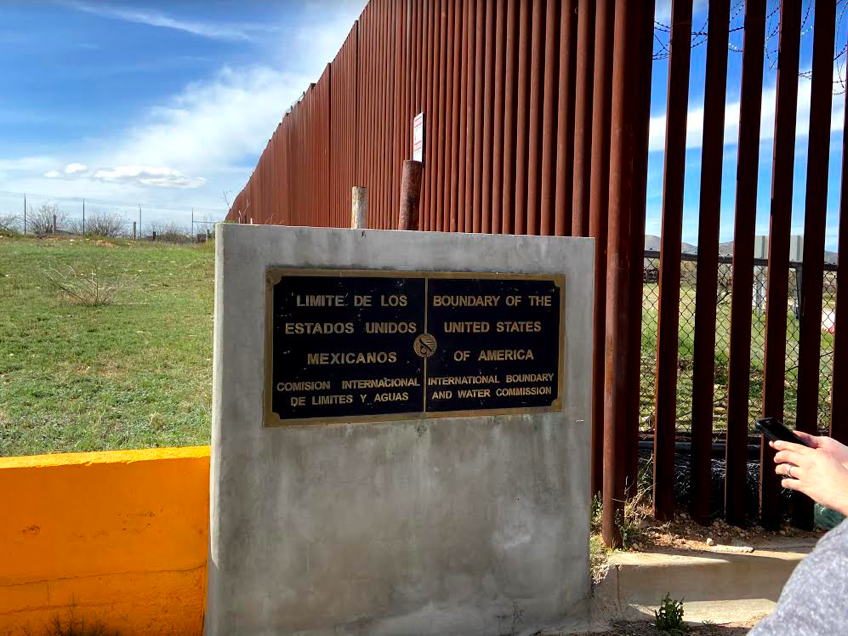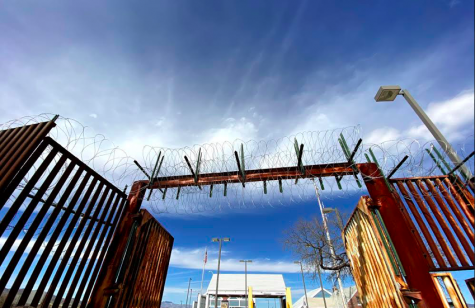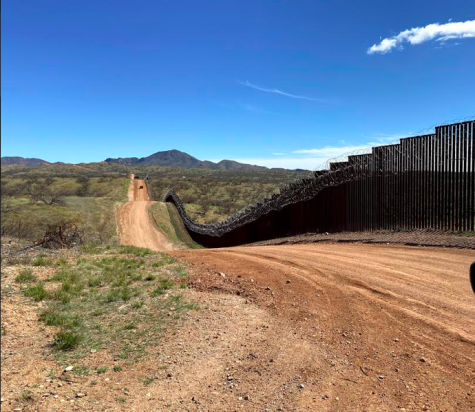Border Stories Part Two: Students and faculty discuss dehumanizing processes at US border
April 14, 2020
Even in the wake of a global pandemic, other issues within the United States don’t go away; they persist even when they’re not in the limelight. A prime example of this is the humanitarian crisis at the United States/Mexico border. As the second and final part to the Border Stories series, four of the 10 Marywood students and faculty share their experience while at the Arizona/Mexico border during spring break.
The idea for this trip began last summer when Assistant Director for Community Learning and Community Service Ann O’Brien reached out to the Associate Professor of Spanish and Latinx Studies Dr. Joshua Deckman informing him about the trip to the border.
At the same time, Deckman was planning to teach a US Latinx Writers course to discuss the different themes that play out across Latinx literature. Deckman wanted to engage with the culture while also offering students the opportunity to see these themes play out in reality.
The group spent most of their time in Tucson, Arizona, working with three different organizations, the Tucson Samaritans, Border Links and Casa Alitas. They also spent one day each at the Arizona border towns of Sasabe and Nogales.
Michael Carone, Junior Social Work major, was drawn to this trip from the start, after applying to be a team leader. Carone says he tries to keep himself informed about immigration, so he felt this was the perfect opportunity to not only help those in need but learn more.
“I knew it was going to be something really interesting and enlightening,” said Carone.
Junior Clinical Psychology Major Corrine Enderline had a similar feeling when it came to choosing a service trip. At first, Enderline was unsure about whether or not she wanted to participate in a service trip this year, but after seeing the choices, she says felt that she needed to go on this trip.
Junior Biology and Spanish Major Krystine Jimenez used the trip to extend her knowledge and passion about immigration that began with her service trip to Connecticut last year and the trip she took to Texas in January. During Jimenez’s trip to Connecticut she worked with a non-profit law office, where she learned about the pathways to citizenship. Jimenez used the Arizona trip as an opportunity to learn more about immigration and Mexican immigrants.
The first organization the group worked with were the Tucson Samaritans, a self-described “healing presence in the desert” that does “water drops” for immigrants crossing through the desert. When the group does a water drop, they will leave water and sometimes cans of food, on the trails for migrants to take during their journey.
Deckman and Jimenez said that while traveling with the Tucson Samaritans, they would find discarded cans of food, bottles of Mexican soda, clothes and water bottles along the trails, all of which help the Samaritans track the immigrants.
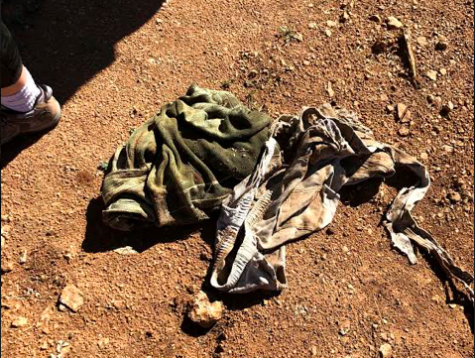
“These [Samaritans] are just people who want to help,” said Jimenez. “They take the time out of their day to learn these routes and to take note of everything and give each other updates about what’s going on. It’s all volunteer based.”
Border Links is an education and activist program that provides information about the border for groups and organizations like the Marywood group. While working with this organization, Carone described learning how the North American Free Trade Agreement (NAFTA) have increased the flow of immigrants, the way that both the United States and Mexico have handled this influx of immigrants and how United States government on both sides of the political spectrum have used aggressive methods to prevent people from crossing.
Carone also talked about the concept of “prevention through deterrence,” whereby the government makes it impossible for immigrants to cross the border legally. Carone said this method does not deter people from crossing the border, but instead forces them to use unsafe methods.
“They’re not migrating on a whim,” said Carone. “They’re doing it to save their lives and save their children’s lives. The only thing that the prevention through deterrence strategy does is make it more dangerous for people to emigrate.”
According to Deckman, when trying to cross legally, the names of immigrants are put on a list that has at least 100,000 other names on it, making it years before their case is heard. The fence, the barbed wire and the wall also make it intimidating to cross legally, he added.
Deckman said that immigrants crossing the border face the deadly climate of the desert as well as trying to track down a guide, known as a coyote, to get them to the border safely.
According to Deckman, these coyotes, often employed by the Mexican Drug cartels, charge exorbitant prices and then lie to immigrants, telling them it’s a short journey when in reality it is much longer, leaving them grossly unprepared for their trip.
“They [the immigrants] are being told that it’s [the border] two miles down the road, but they’re walking maybe five miles in the dark, with no idea where they’re going and they’re falling behind,” Deckman said. “If they fall behind, they are usually left behind and left for dead.”
While working with the Samaritans, Enderline recalled a story that one of the volunteers named Gail, told while on a water drop. Gail was eating an apple during a water drop and came across a group of migrants. She offered the apple to one of the migrants and rather than just eating the whole thing himself, he offered a piece to each person in their group. After hearing that story, Enderline recalled Gail saying, “These are the people we are doing this to. They’re just people like the rest of us.”
Even if immigrants make it past this perilous journey, some migrants may be detained and immediately deported through another deterrence tactic known as Operation Streamline (link). Operation Streamline was implemented in 2005 by the Department of Homeland Security as a way to rapidly prosecute and deport as many undocumented migrants as possible and enforce a “zero tolerance” policy for undocumented immigrants.
While in Arizona, the group witnessed Operation Streamline hearings. Enderline said they were there for about an hour, while the court processed and deported 65 migrants back to Mexico or Central America.
During the process Enderline and the group witnessed, the migrants were filed into the courtroom about 15-20 at a time to stand before a judge. From there, between eight and 10 migrants were brought up in rows to stand in front of the judge. A statement was read, the judge went down the row and addressed each migrant by their name, read them their rights and then sentenced them to deportation. This continued throughout the whole day, taking 45 minutes to an hour per session.
Describing the scene itself, Enderline recalled it being initially overwhelming because of how dehumanizing it was, but due to the hearings’ rapid pace, she got used to it.
“At first, I was really emotional because you’re seeing everyone treated like this,” said Enderline. “Eventually, though, it’s just happening so quickly that you get desensitized to it and it becomes another round.”
When reflecting on how the prosecutors, defenders, judge and marshals were behaving, Enderline was hesitant to say that the law enforcement officers didn’t care, but noted that they appeared that way.
“This is happening every day and there are thousands of people that they’re doing this to,” said Enderline.
What stuck out to Carone, though, was the difference between the attitudes of the judges, lawyers and marshals, and those of the migrants facing deportation.
“Before it all started, all of the public defenders were just joking around with each other and it was a very stark contrast between these people who have been arrested and basically told to plead guilty,” said Carone.
Jimenez related what she witnessed during the Operation Streamline trial to her mother’s story of living as an undocumented immigrant in the United States for some time.
“There was a room of 65 people who all had a story and you just get angry at the fact that they have nothing else, and then they try to come over and they just want a better future and its impossible to get it,” said Jimenez.
Outside of the physical death at the border, there was the concept of “social death” that the group witnessed as well. As explained by Deckman, social death is a term used to define the treatment and conditions that people who are viewed as sub-human by society face. Deckman related this to the dramatization of the border and the desire to not allow particular groups of people in the country because they are “other.”
“Even if they’re not saints, they still deserve to be treated with dignity and respect and they got neither of those when they came here,” said Carone when talking about how the migrants were treated. “They still deserve to be treated like a person and they’re just not [getting that].”
While the group did not have the opportunity to meet a lot of people at the border, Jimenez recalled a man they spoke with while working with Border Links. The man spoke only Spanish, but he would tell his story to anyone who would listen, hoping that others would share his story too. Jimenez recalled the man saying that while he would not witness change taking place, he knew that change is coming.
One portion of the trip that really stuck out to Carone was the border wall that ran right through the center of Nogales, Arizona and the people living in the city who seemed to have completely adapted to it.
“It was one city split in two because of where we say the border is,” said Carone.
When talking about the wall, Deckman described how the group saw a girl casually having a conversation with her friend who was on the Mexico side of the wall. According to the rest of the group, this is not an uncommon event.
“People throw gifts from one side to the other,” said Deckman. “They pass notes. It’s almost become normal to talk through or pass things over the wall.”
Jimenez recalled a man from Border Links telling a story about how he and his family met at the wall because they had not seen each other in months.
“You think you’re seeing them, but it’s not the same,” said Jimenez. “You can’t even stick your hand through to give them a handshake because of the bars and the fence.”
“Life goes on and people adapt, and they make the best out of bad situations,” said Carone.
Reflecting on their trip and what they experienced, Deckman and Jimenez wished more people heard the migrants’ stories. Both Deckman and Jimenez felt that because of the way this topic is portrayed in the media, the experiences these migrants go through are not talked about as they should be.
“I think it’s necessary to hear their voice and to listen to their stories to see where they’re coming from,” said Deckman.
“I don’t think that we can truly get a feel of why people do this unless you talk to someone who has experienced it,” said Jimenez.
Jimenez also reinforced the idea that these are just people looking for a better life and a better opportunity and are portrayed as bad people because of it.
“Them looking at the United States as a sense of hope is beautiful because they see it as a place they can come to,” said Jimenez. “I definitely do think that there need to be a lot of changes overall with how we handle the situation.”
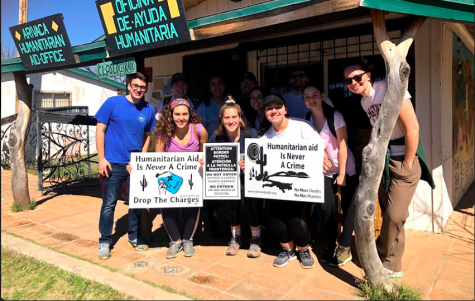
Photo taken by members of the Arizona Service Trip
Contact the writer: [email protected]



